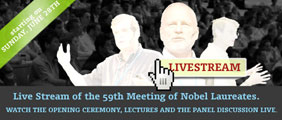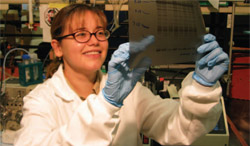John Schwab here, reporting from the 59th Meeting of Nobel Laureates on the Island of Lindau on Bodensee, near the point where Germany, Switzerland and Austria meet. Since 1951, the annual Lindau meetings have sought to educate, inspire and connect generations of scientists. There are 583 young scientists here from around the world, including about 70 graduate students from the United States. NIGMS is sponsoring the participation of 16 of these students, and this is the first year that NIH has joined DOE, NSF and others in supporting graduate students to attend.
 This year’s meeting is dedicated to chemistry. As you know, NIGMS supports lots of basic science, which includes different “flavors” of chemistry. Many chemistry Nobel laureates are, or have been, NIGMS grantees. Several of them—such as Robert Grubbs, Richard Schrock and Roger Tsien —are among the 23 laureates attending the Lindau meeting.
This year’s meeting is dedicated to chemistry. As you know, NIGMS supports lots of basic science, which includes different “flavors” of chemistry. Many chemistry Nobel laureates are, or have been, NIGMS grantees. Several of them—such as Robert Grubbs, Richard Schrock and Roger Tsien —are among the 23 laureates attending the Lindau meeting.
During the week-long symposium, our students are networking with their international colleagues, being exposed to the entire spectrum of chemistry laureates and participating in discussions about science and society. The students are generally in their second or third year (some are in their fourth). They’re a very bright and motivated group. They’re experienced enough to understand much of the science, and they’re really excited to be here.
The talks so far have covered quite a range. Here are a few highlights:
- Gerhard Ertl spoke about surface science and showed time-resolved images of individual atoms moving around and self-organizing on a surface. Amazing!
- Sherwood Rowland and Paul Crutzen spoke about atmospheric chemistry, greenhouse gases and global warming. This was the science behind the project for which Al Gore won the Nobel Peace Prize. Very exciting yet sobering.
- Ryoji Noyori gave a pure science talk about asymmetric catalysis.
- Hartmut Michel spoke about the structure and function of cytochrome C oxidase, a membrane protein.
One of the most interesting and unconventional talks was given by NMR spectroscopist Richard Ernst and titled “Passions and Activities Beyond Science.” He talked about the inspiration and pleasure he has gotten from his study of Buddhism and Tibetan art. His interest ranges from history to culture to fine art to the science of restoration of ancient artwork. His message was an important one for the students: that science need not be the only passion of a productive and creative scientist—that being a scientist doesn’t have to mean being narrowly focused!
I’ve been enjoying “spreading the word” about what NIGMS is all about, and I’m looking forward to yet more stimulating science and fun interactions with a group of bright, creative students.


 If you plan to apply, be sure to read the recent NIH Guide notice applying to NRSAs. Effective with the August 8, 2009, submission date, NIH will only accept electronic applications for F-series programs. There are other changes, too, including how letters of reference are submitted, how many amended applications you may submit (only one), and how review is structured (there are now five review criteria). In addition, reviewers will use the new scoring system for individual fellowships starting with applications reviewed at the summer 2009 study section meetings.
If you plan to apply, be sure to read the recent NIH Guide notice applying to NRSAs. Effective with the August 8, 2009, submission date, NIH will only accept electronic applications for F-series programs. There are other changes, too, including how letters of reference are submitted, how many amended applications you may submit (only one), and how review is structured (there are now five review criteria). In addition, reviewers will use the new scoring system for individual fellowships starting with applications reviewed at the summer 2009 study section meetings.